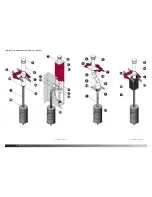
www.morsona.com
[ 20 ]
[ 21 ]
1. How to light the stove
As shown in the picture to the left you need the following:
2 fire lighthers (or 5-10 scrunched-up sheets of newspaper)
1 kg of dry kindling
Approx. 2-3 lbs. of chopped firewood
2. You should always have an insulating layer of ashes from
previous firings in the bottom of the fire chamber.
1” of ash is a suitable base for the wood.
Start by placing a couple of logs, approzimately 1 lb., in the
bottom of the burn chamber.
3. Arrange the kindling
Place approximately 2 lbs. of dry kindling wood on top of the
logs. Place a couple of kindling bags or newspaper just below
the top layer of kindling wood.
4. Lighting the kindling
Light the kindling bags or newspaper
5. Before lighting, fully open the primary air supply.
The flames work their way slowly downwards from the top.
6. Leave the stove door ajar
After 5-10 minutes the heat will produce draft through the
chimney, and the door can be shut.
7. Embers
After approximately 45-60 minutes, the last flames go out,
and a good layer of embers has been formed. More wood
should be added while there are still glowing embers. Use a
poker or ash scraper to spread the embers, but ensure that
most of them are positioneded at the front of the stove.
8. Re-Fuelling
Place three pieces of wood of approx ½ lb. each and approx.
9,8" long over the embers in a single layer, with a distance of
approx. ½” between each piece.
When the air controls are opened fully, and the door is closed,
the wood will ignite within 2-3 minutes.
9. Optimal combustion
Finally, adjust the air supply control to the required position
to give optimal combustion. Maintaining a good fire box tem-
perature will ensure secondary combustion of the smoke and
gases giving a clean and efficient burn. The stove should be
refuelled only while glowing embers remain.
10. How much ash should be left in the stove?
Keep a 1" thick layer of insulating ash. The ash layer insula-
tes the bottom of the stove in the same way as the fire bricks
or vermiculite board on the sides of the stove. This ensures a
high combustion temperature which contributes to a cleaner
more efficient combustion.
Furthermore, the ash layer protects the grate against pre-
mature failure and increasing its life expectancy. Empty the
ashpan as required. Store any hot ashes in a suitable non-
combustibleash bucket until all embers are fully extinguis-
hed, cold ash can then be disposed of with the rest of your
household waste.
How to light your stove



































